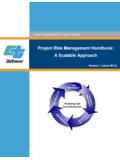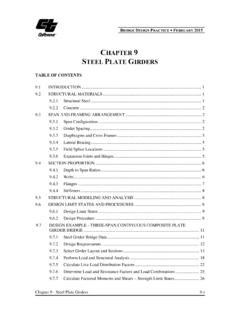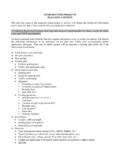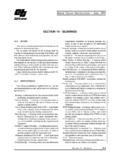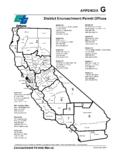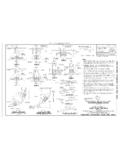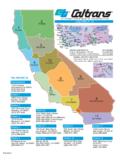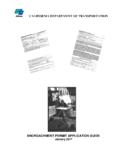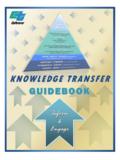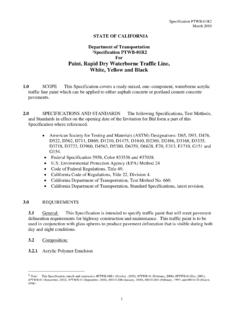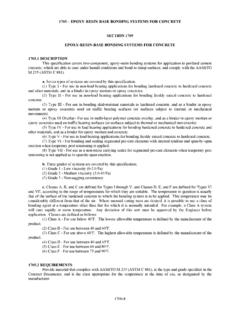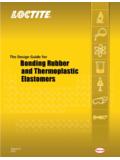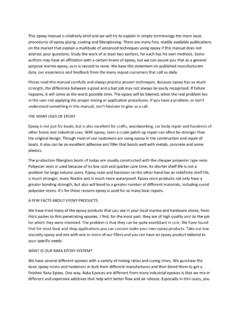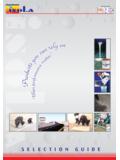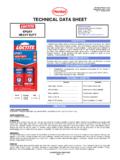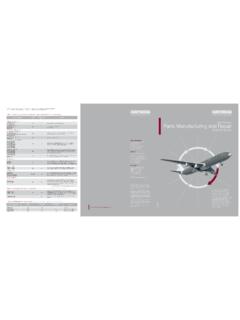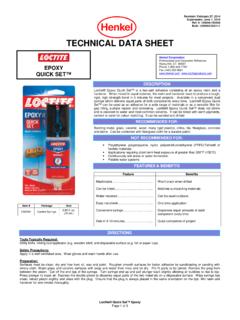Transcription of 5-81 A to oncrete - California Department of Transportation
1 5-81 AnchorAge to concrete 1 LRFDB ridge design Aids 5-81 JAnuAry 20125-81 AnchorAge to concrete1. IntroductionSteel-to-concrete or concrete-to-concrete connections can be accomplished through the use of several types of anchorage systems. This design aid describes the concrete anchor systems that are most widely used on Caltrans jobs and assists the designer in selecting the system that is best suited for a particular Anchor Systems and Design CriteriaThere are two broad types of anchor systems post-installed anchors and cast-in-place (CIP) design recommendations for post-installed anchors in this aid conform to the requirements in the California Amendments to AASHTO LRFD Bridge Design Specifications. For CIP anchors, the design recommendations are based on ACI 318-08 as well as California Amendments to AASHTO LRFD Bridge Design Specifications. The designer should determine the loading combinations and the corresponding load factors for each Post-Installed Anchors This type of an anchor is installed in a hole that is drilled in hardened concrete.
2 There are two main types of post-installed anchors Mechanical Expansion Anchors (MEA) and Bonded Mechanical Expansion AnchorsMEAs are inserted in pre-drilled holes. These anchors expand and bear against the concrete surface and are placed using any of the following techniques:a) Hammering the anchor (deformation controlled)b) Tightening a nut (torque controlled) c) Expanding into an undercut (expanding into a notched opening at the bottom of a hole).Bridge design Aids 5-81 JAnuAry 20122 5-81 AnchorAge to concreteLRFDMEAs are frequently used to anchor minor or temporary attachments such as signs, brackets, inspection ladders, safety railing, utility pipes and light fixtures to hardened concrete. MEAs have the following advantages: Are inexpensive Are quick and easy to install Can be installed in any orientation Loading can be applied immediately after installationMEAs have the following disadvantages: Have relatively small tensile strength Are not recommended for use in tension zone where concrete is likely to crack Are not suitable for resisting dynamic (vehicle loading, seismic etc.
3 Or vibratory loadsMaterials and installation methods of MEAs must comply with the requirements of Section 75 of the Standard Specifications. Designers should refer to the Caltrans Authorized Materials List for a list of approved on tests performed at the Transportation Laboratory (Translab) by the Office of Structure Materials, METS, the following two types of MEAs are currently approved for use on Caltrans projects [John P. Dusel and Craig N. Harrington, 1986]: a) Shell expansion anchor with internal threads This anchor requires an independent stud, nut and washer, and is stronger in tension than other types of shell ) Integral stud anchor (wedge type and external plug) This anchor, which is furnished with nuts and washers, is easier to install in a multi-hole base plate and is stronger in shear. Figure shows some common types of prior testing, other types of MEAs (example: undercut anchors) may be approved for use on Caltrans jobs.
4 While undercut anchors are relatively more expensive than shell and stud type anchors since additional drilling is required, they are better suited for dynamic loads. 5-81 AnchorAge to concrete 3 LRFDB ridge design Aids 5-81 JAnuAry 2012 Self-drilling MEAs, because of a potential for fatigue-related cracking in the hardened skirt, are not approved. Stud sleeve anchors are also not approved because they have exhibited large displacements in the Translab certain conditions, Resin Capsule Anchors (as discussed in a later section) may also be used as an alternative to MEAs. Independent studExpander plugShell bodyFace of ConcreteMemberNut and washerDepth of recessto top of shell1/2 min1 maxIntegral studSliding collarTypical Shell - Type MEAT ypical Stud - Type MEAConeFigure Common Types of Resistance (Design Strength)Generally, expansion anchors that are loaded in tension fail by initial slipping followed by concrete cone failure.
5 The tensile resistance (design tension strength) of a MEA is based on its creep performance rather than the yield strength of the material. This design strength corresponds to a sustained tension load, that will cause the anchor to slip at a higher rate as the load increases, multiplied by a resistance (strength reduction) factor of .Table lists the shear and tensile design strengths of shell and stud-type design strengths listed in Table are valid for the following conditions:a) For static load conditions only. When dynamic loading governs or for critical applications such as installations Bridge design Aids 5-81 JAnuAry 2012 5-81 AnchorAge to concreteLRFD over traffic, CIP anchors should be the preferred option. If CIP anchors cannot be provided, then Resin Capsule Anchors or bonded anchors may be ) For normal weight concrete having cf = 000 psi. For other concrete strengths, multiply the values in the table by: 4000)(actualf'cc) For an edge distance of 6dh or greater (where dh is the hole diameter and is considered equal to the nominal diameter of the anchor plus 1/8" ).
6 Edge distance can be reduced down to 3dh if the design strength is also linearly reduced to 50%. An edge distance of less than 3dh is not ) For a center-to-center spacing between anchors of 12dh or greater ( , 100% effective). This spacing can be reduced down to 6dh if the design strength is linearly reduced to 50% of that shown in Table ) When multiple anchors are used to hold an attachment. If a single MEA is used to hold an attachment, then the design strengths shown in should be reduced by 50%.f) When an anchor is subjected to combined tension and shear loading, the following equation should be satisfied:1 +resistancetensileFactoredloadtensileFac toredresistanceshearactoredFloadshearFac toredTable Factored Resistance (Design Strength) for Shell and Stud-Type MEAsStud Diameter (inches)Shear Strength (kips)Tensile Strength (kips)1/ 0. 0. 3 2. 2. 5-81 AnchorAge to concrete 5 LRFDB ridge design Aids 5-81 JAnuAry Design and Detail GuidelinesThe Designers should consider the following issues when MEAs are selected:a) The Plans should show the size of MEA required, but not show the depth or the diameter of the hole the size of the hole is addressed in the Standard Specifications.
7 Figure shows a typical detail for MEAs to be used in the ) The thickness of concrete, where an anchor is embedded should be adequate to resist driving forces during anchor seating typically, the minimum concrete thickness should be times the depth of ) To ensure proper seating of shell type MEAs, the top of the shell body is typically recessed between 1/2" and 1" below the concrete surface, and an independent threaded stud rather than a headed bolt is ) As the design strength of shell and stud type MEAs is governed by creep considerations, the maximum anchor size is limited to 3/ ) In corrosive environments, use other anchorage systems. While there are no pre-approved MEAs for this environment, stainless steel MEAs should be considered on a job-by-job MechanicalExpansion Anchor Figure Typical Detail for MEAsBridge design Aids 5-81 JAnuAry 20126 5-81 AnchorAge to Bonded AnchorsBonded anchor systems include the following: a) Drill and Bond Dowel: Magnesium phosphate (mag-phos) is used as a bonding agent (see Section 51 of the Standard Specifications).
8 Mag-phos concrete hardens or cures in about three hours and does not require any special treatment during curing. It also develops full strength in three days. Mag-phos has the following advantages: Has relatively high tensile strength Has quick setting time Exhibits minimal shrinkage. Mag-phos has the following disadvantages: Can not come into contact with zinc, aluminum, copper or cadmium ( , Mag-phos cannot be used for galvanized anchors) Is not likely to be fully effective in cracked concreteb) Drill and Grout Dowel: Neat portland cement paste (grout) is used as a bonding agent (see Section 51 of the Standard Specifications). Generally, cement grout is less expensive than mag-phos concrete, but cures more slowly. Grout has to be cured for at least three days during which time the dowels should not be disturbed. The grout normally develops 50% of its strength in three days, and reaches full strength in about 28 days.
9 In addition, grout has a tendency to shrink leading to ) Drill and Epoxy Bond Dowel: Bulk epoxy is used as the bonding agent. This method of bonding anchors to concrete is no longer used in structural applications as several bulk epoxies exhibit high creep characteristics under sustained tensile loads. In addition these epoxies may require exact mix ratios and are sensitive to freeze/thaw conditions. d) Drill and Bond Dowel (chemical adhesive): A chemical adhesive or a cartridge epoxy is used as a bonding agent (see Section 51 of the Standard Specifications). 5-81 AnchorAge to concrete 7 LRFDB ridge design Aids 5-81 JAnuAry 2012 The advantages of chemical adhesives include: Higher viscosity (than mag-phos or grout) that helps the adhesive to be retained in a drilled hole Relatively quick setting time Low shrinkageOne of the disadvantages of this system is the need for stringent quality control and quality assurance testing, particularly since creep deformations can be a chemical adhesives in drill and bond applications must be pre-approved and listed under the Authorized Material List prior to use on Caltrans anchors provide a simple, effective, economical and preferred system for attaching metal fixtures or new concrete to existing/hardened concrete.
10 In this system , bar reinforcement dowels or threaded rods are placed in drilled holes filled with either grout or a bonding material. Typically, bonded anchors are used for attaching new bridge barriers, sign frames or electroliers onto existing bridge decks, widening bridge abutments and bridge decks, and in seismic retrofits. Applications Typical applications of different types of bonded anchors are discussed in the following:a) In general, drill and grout, drill and bond or drill and epoxy bond dowels should be used only in holes drilled at a downward angle of at least 20 degrees to the horizontal generally detailed as a 3:1 slope on Plans. b) Drill and Bond (Chemical Adhesives) dowels should be used when a drilled hole at a 3:1 slope cannot be achieved. In horizontal holes, chemical adhesives should always be used since the adhesives have a higher viscosity (example: in deck overhangs where horizontal holes may be the only option due to small deck thickness).
